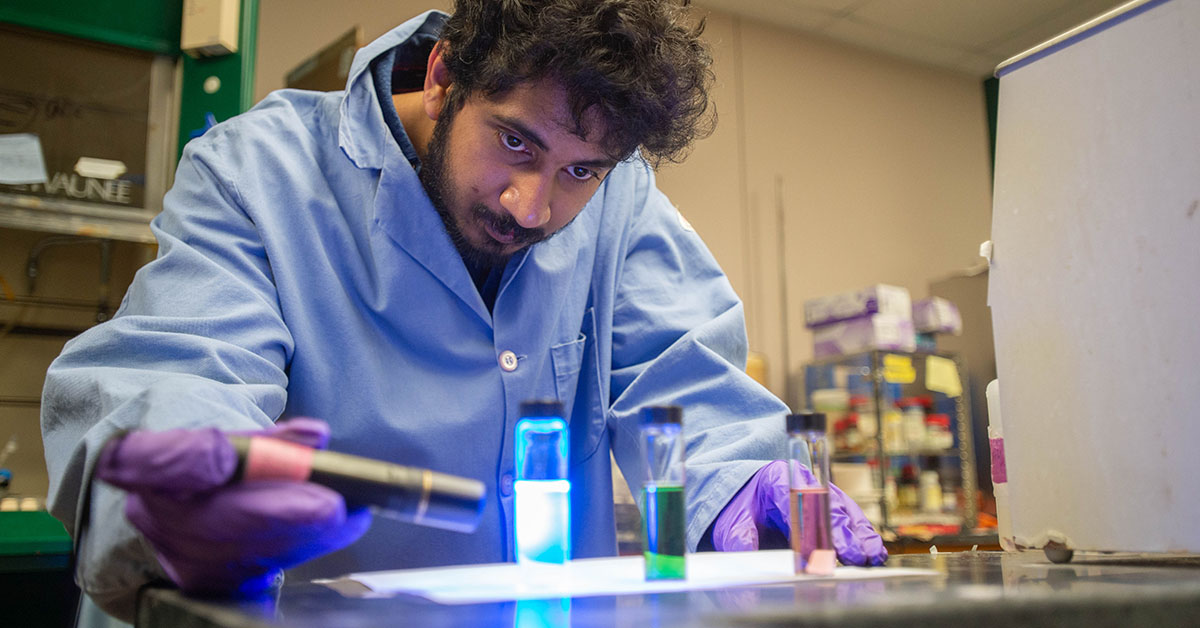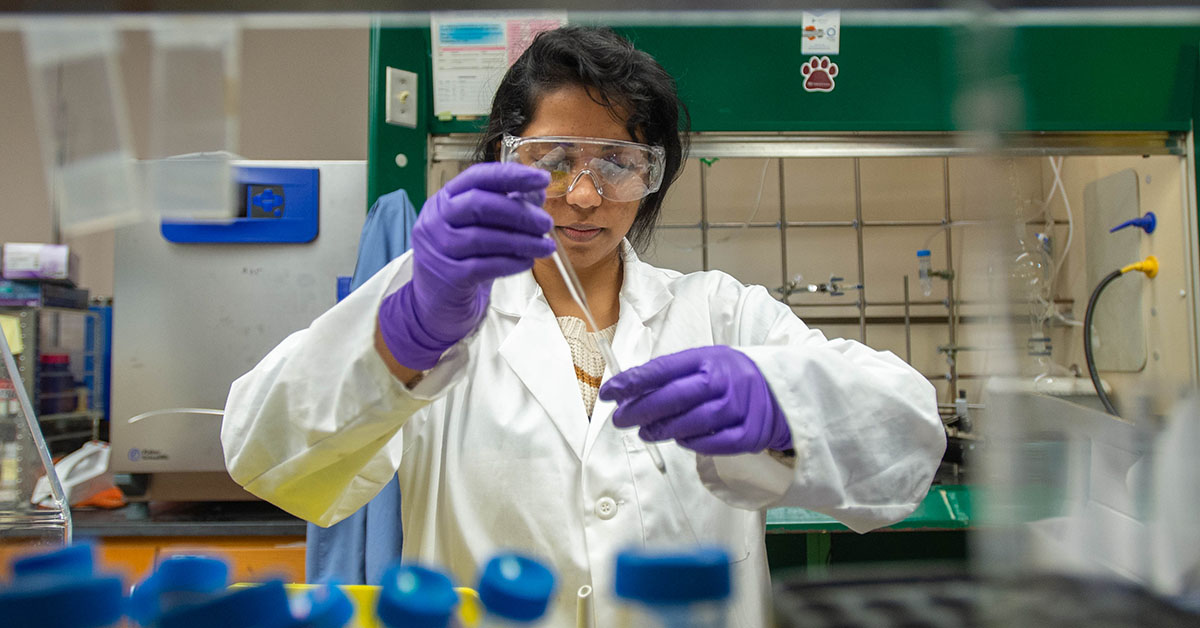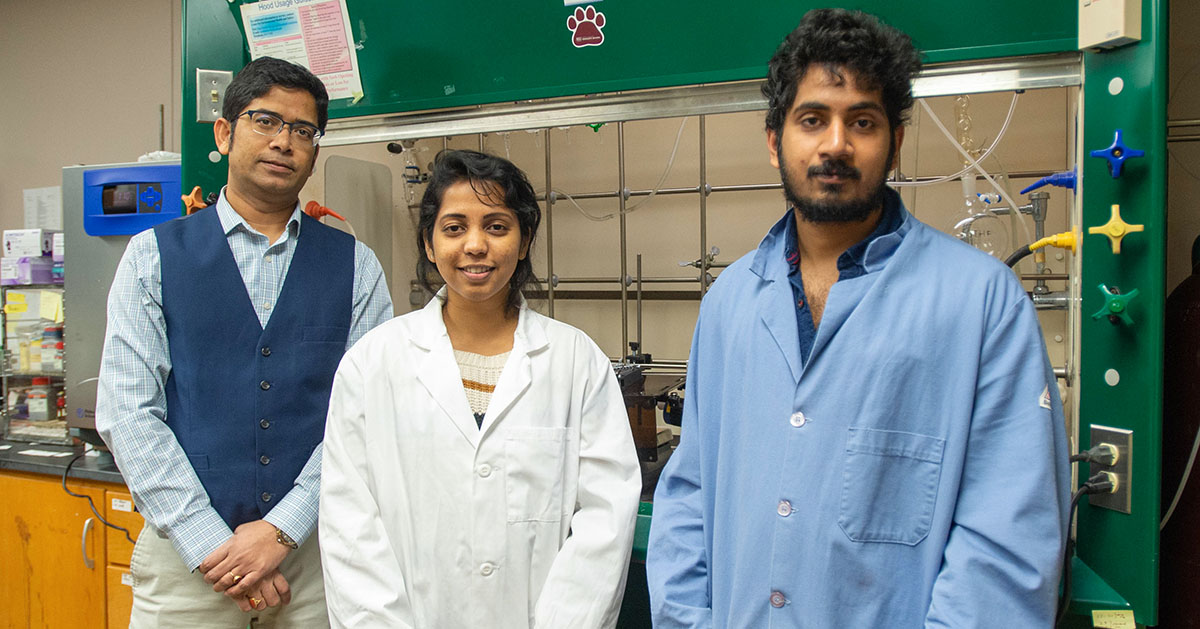
Sreehari S. Rajasree, and Riya Krishnan, below, both doctoral students in chemistry, work on experiments aimed at developing more efficient and targeted ways of using light to drive chemical reactions. Pravas Deria, associate professor in the School of Chemical and Biomolecular Sciences, is leading the work, funded by a $418,000 grant from the National Institutes of Health.
February 08, 2023
SIU research team explores how light and chemistry may perfect how meds are made
CARBONDALE, Ill. – Two cars leaving from opposite cities traveling toward each other will meet more quickly than one car driving all the way to the other car sitting stationary. That’s the fundamental premise behind a Southern Illinois University Carbondale researcher’s newly funded project using light and chemistry to improve how medicines are made.
Pravas Deria, associate professor in the School of Chemical and Biomolecular Sciences, is trying to develop a more efficient and targeted way of using light to drive chemical reactions. The new technology could pave ways to prepare important organic compounds for use in medicines.
The National Institutes of Health is funding the work, providing more than $418,000 over three years, which began last fall.
Photocatalysis, the process of accelerating a chemical reaction using light in the presence of a catalyst, currently is used in the manufacture of paints, paper and fuels. Such light-driven transformations are carried out in solution where a sensitizer, called a photocatalyst, absorbs light and enters an excited state, or has a lot more energy. It then uses that energy to activate chemical reagents, which are substances that cause transformations through a chemical reaction to form the desired produce molecules.
But this technique requires cumbersome and expensive separation from large amounts of solution, making them unwieldy and inefficient.
A new concept
Deria is developing selective photocatalysts for organic synthesis using technology based on solid-state compositions. The work could lead to a new “flow-photochemistry” process, where the active materials are loaded in thin, narrow columns, which are then hit with lights or wrapped in LED strips.
A scaled-up system, used on an industrial plant, might solve the separation issues, and allow recycling of the expensive photocatalysts.
“At that point, all we need would be to pass our starting materials through it to get the product out,” Deria said. “And this process could be done without any oxidized side product formed, which is typical in other photo reactions.”
 Guiding what happens to an excited molecule is where it gets tricky. Deria is finding ways to control this “selectivity,” which could ultimately determine how its specific bioactivity creates molecules that can be used in medicines.
Guiding what happens to an excited molecule is where it gets tricky. Deria is finding ways to control this “selectivity,” which could ultimately determine how its specific bioactivity creates molecules that can be used in medicines.
“Creating efficient solid-state photocatalysts itself is challenging. It’s like the car analogy,” Deria said. “If you go the beyond that, creating selective solid-state photocatalysts that can be useful and with minimum separation efforts is even further challenging.”
Significant challenges
But to make solid-state photocatalysts possible, scientists must discover how to move the excited energy without diffusing the molecules within the working solid materials. Deria is working on this long-term stability challenge, taking a cue from Mother Nature’s way of making the chlorophyll assembly in plants.
“So, this kind of a stability is a billion-years-old problem, for which nature has found a solution,” he said.
Deria is especially familiar with this concept, having a received a prestigious $642,000 CAREER grant from the National Science Foundation in 2019 to study the fundamental process of assembling tiny, metal-organic structures that potentially could convert the sun’s energy into stored chemical energy.
“This new research takes some key lessons from that work on how to move and deliver photo-excited energy without moving their host,” Deria said.
Students highly involved
The team, including Deria’s students, is experimenting with newly designed catalysts in glass vials bathed with a household fluorescent light of 15 watts or less. Both undergraduates and graduate students will be participating, a hallmark of research at SIU.
“We check the progress with a gas chromatograph,” Deria said. “You can think of simply putting such vial at the window under the sunlight. It’s very exciting.”
Success will mean discovering a fundamental process that would allow engineers to design factories to take advantage of its increased efficiency.
“If one wants to develop large, industrial-scale setups, then it’s advantageous to design solid catalysts,” Deria said. “This would reduce the solvent usage and avoid the separation process that is also involved.”

A researcher at SIU is developing more efficient and targeted ways of using light to drive chemical reactions. Pravas Deria, left, associate professor in the School of Chemical and Biomolecular Sciences, is leading the work, funded by a $418,000 grant from the National Institutes of Health. Chemistry doctoral students Riya Krishnan, center, and Sreehari S. Rajasree are assisting with the work.
